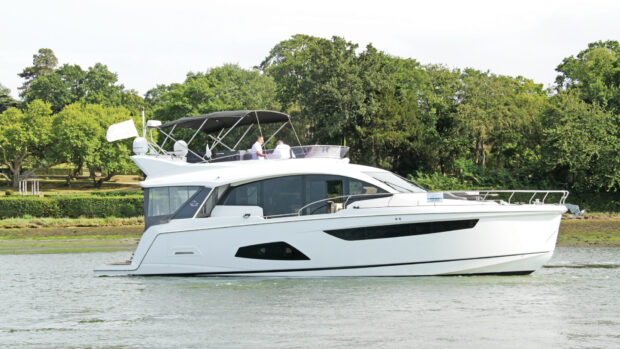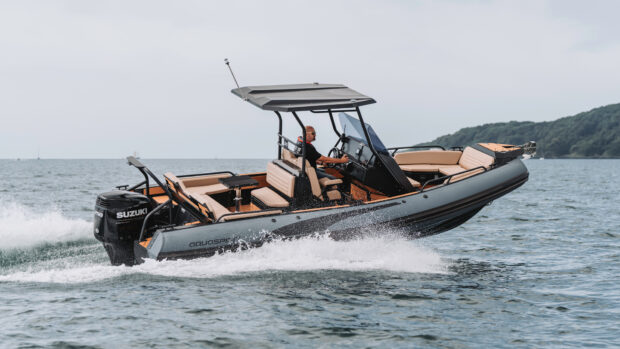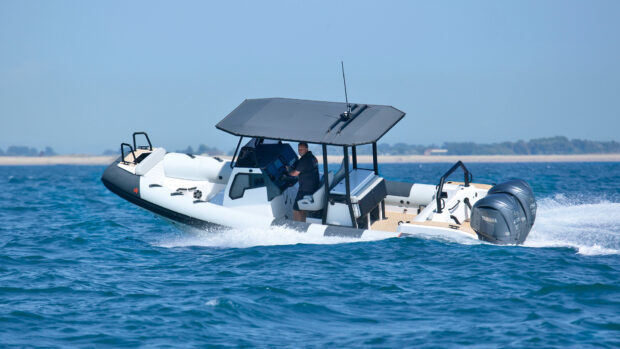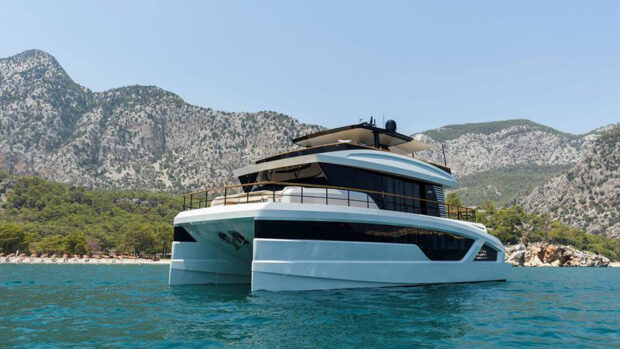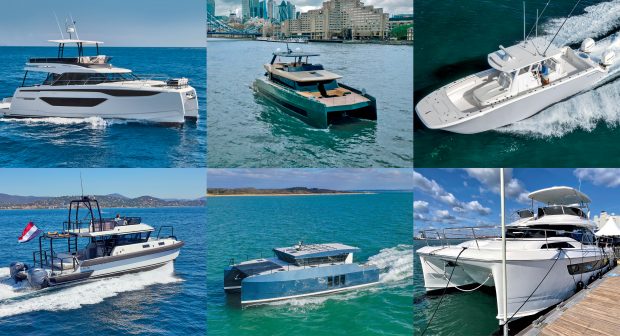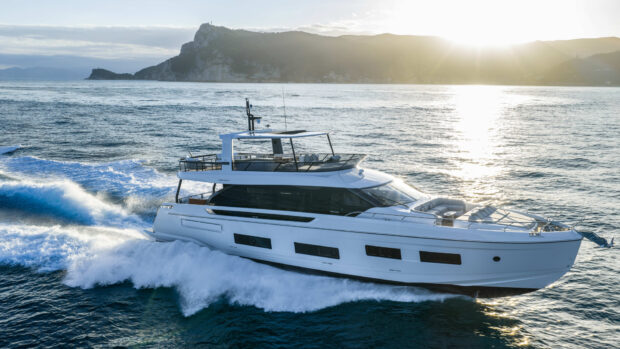Is Windy's new walkaround sportscruiser, the Windy SR40 the missing link in Windy’s range we’ve all been waiting for?
For a long period back in the 1990s and 2000s Windy was one of the dominant forces in the 35-45ft hard top sportscruiser sector. Boats like the 37 Grand Mistral, 40 Maestro and 44 Chinook offered a sporty, practical and beautifully built Scandinavian alternative to the usual Fairline Targas and Princess V40s of their era.
Then for reasons we still don’t fully understand, Windy turned its back on the mainstream hard top sportscruiser market in favour of larger superyacht style chase boats and pure open sportsboats.
Both these new ranges still have the performance, handling and build quality to mix it with the best but for UK and Northern Europe waters, where summers are short and superyachts rarely linger, they simply aren’t as versatile or as well suited as their predecessors used to be.
That’s where this new Windy SR40 comes in. Technically, it’s the third model in the SR Sports Boat range that spans the gap between the classic open sportsboats and the semi-custom superyacht tenders; but whereas the other two models in the range, the Windy SR28 CC and the Windy SR44, are effectively open boats with a rigid sunshade overhead, the new Windy SR40 has a full wraparound hardtop providing protection from the sun, wind, rain and spray.
In fact the Windy SR40 is even more versatile than that because thanks to two large sliding side doors and opening sunroofs, it also does a very good imitation of an open boat when conditions allow.
Throw in the safety and convenience of its deep walkaround side decks, a decent cabin and heads for overnighting, and the option of both efficient diesel power or sizzling outboard performance and it’s starting to sound like all things to all people.
The big question is whether it can do all this and still deliver the soft ride and dynamic handling for which Windys are rightly renowned.
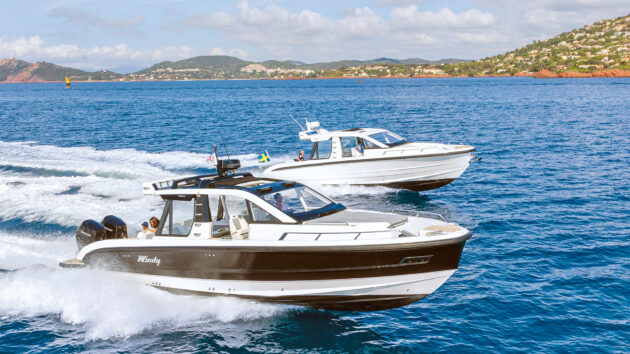
Diesel inboard or petrol outboard gives buyers a wide choice of options. Photos: Jerome Kelagopian & Hugo Andreae
Superyacht Style
As luck would have it the very first diesel powered Windy SR40 off the line was bought by MBY reader and Our Boats contributor Tim Innes and it was he, along with the French dealer Merveille Nautic, who granted us an exclusive opportunity to test it, fresh from its world debut at the Palma Boat Show.
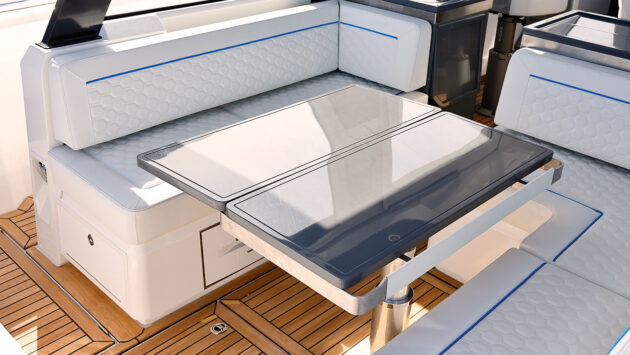
There’s storage under the seats and an optional extra fridge. Photos: Jerome Kelagopian & Hugo Andreae
However, before we get to the subject of how well it drives, it’s worth taking a moment to delve into the SR40’s layout and its long list of optional extras. As with the W37 Shamal, W34 Alize and W29 Huracan, the SR40’s hull and exterior were penned by the Norwegian born superyacht designer Espen Øino, while the cockpit and interior styling were the work of British company Design Unlimited, best known for its work with Sunseeker.
Any concerns that this might lead to a boat with more show than go are swiftly dispelled when you see the end result; the brief was to create a ‘fast and safe multi-purpose family sportsboat with the emphasis on the practical aspects of boating’ and the finished design certainly lives up to that billing.
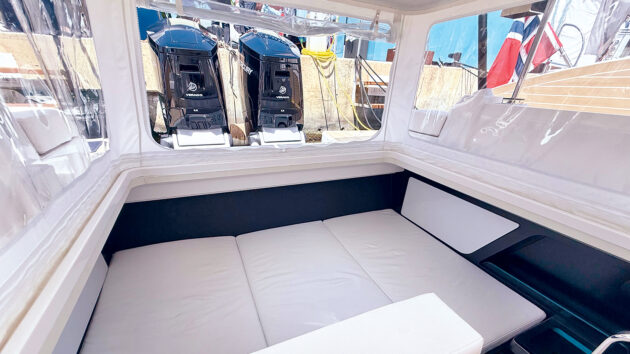
The pop-up aft cabin tent is only an option on the outboard boat. Photos: Jerome Kelagopian & Hugo Andreae
Deck layout
With its secure walkaround decks protected behind waist-high bulwarks, it’s a very safe and easy boat to move around with much better access to the foredeck sunpad and anchoring gear than the step-thru windscreen designs of Windy’s open sportscruisers.
Everyday jobs like rigging the lines and fenders or checking the anchor gear are a doddle, helped by strategically located lockers under both side decks as well as the foredeck and cockpit. Some of these were missing Windy’s usual lift-out baskets, which let wet ropes and fenders dry out and make retrieving them even easier, but we’re assured this was just a supply issue with the test boat and they will be added later.
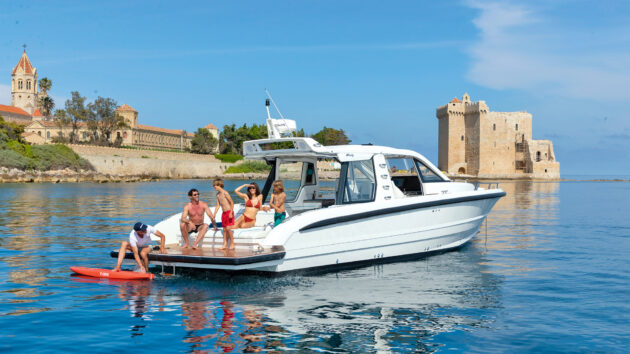
The sliding side doors align with the rear windows when opened so the outlook remains the same. Photos: Jerome Kelagopian & Hugo Andreae
That hard top is also a very practical piece of design. Technically, the sliding side doors are a €16,800 option but it’s hard to imagine anyone choosing not to spec them as they make for a much better protected helm and seating area when closed but are almost invisible when slid back into the open position.
They also feel impressively solid with a reliable heavy duty manual mechanism that locks them into one of three preset positions and avoids the usual squeaks and rattles which afflict cheaper designs. There is no option for a rear set of doors but you can still enclose the aft end of the cockpit with canopies when needed.
Optional electric sunroofs over the helm and dinette (as standard they are fixed glass skylights) open things up even more, while roof rack bars for mounting paddleboards, kayaks or even bike holders add further versatility to the hard top. Steps moulded into the side pillars enable relatively easy access to these.
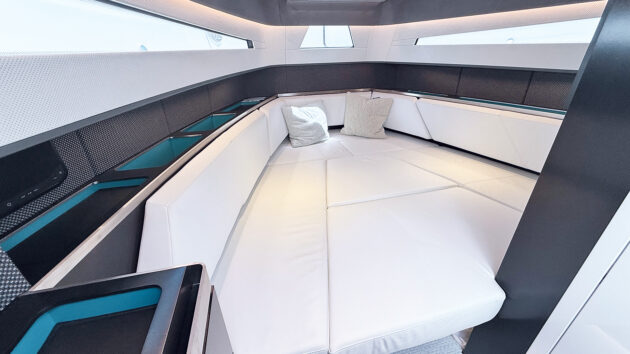
The vee-shaped dinette makes up into a bed at night. Photos: Jerome Kelagopian & Hugo Andreae
The other major novelty is a pair of folding balconies on either side of the aft cockpit. At €77,000, they are a big ticket option but it’s not hard to see why Med users might feel they’re worth it for the beach club vibe they offer.
The rest of the cockpit is more conventionally Windy but none the worse for it. The aft bench/sunpad is a particularly smart piece of design with angled side bolsters providing added security under way and a sliding backrest that varies the split between cockpit seating and sunpad, and allows its occupants to face forwards, backwards or both.
In forward-facing bench mode it’s a little too far from the dinette table to sit and eat but it does form the fourth side of a very sociable square of seating. An optional sun awning with slot-in carbon poles extends the shade all the way aft when needed.
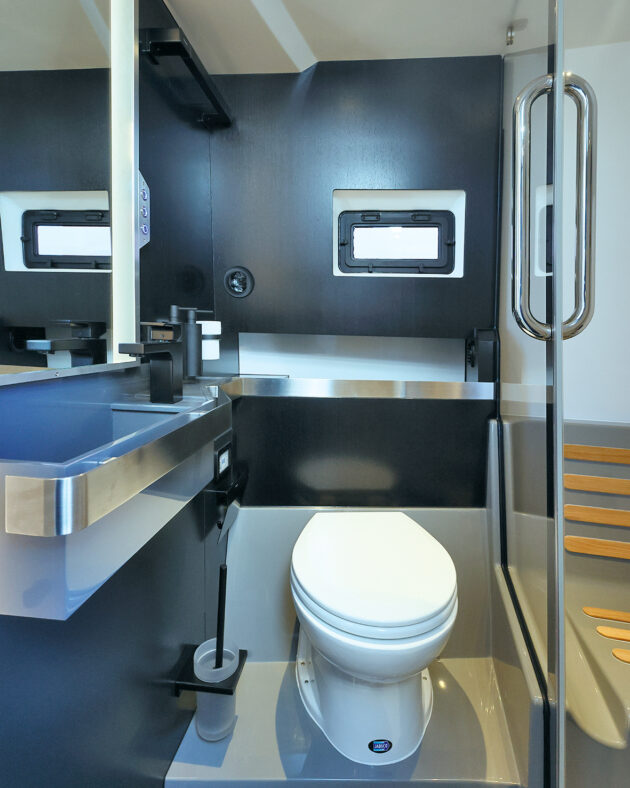
The day heads has standing headroom and a separate shower compartment. Photos: Jerome Kelagopian & Hugo Andreae
A pair of wet bars separate the seating area from the helm station. The port one is largely taken up by a top-loading chilled locker, while the starboard one houses the sink, crockery and options for a Kenyon grille or induction hob.
Silwy plates and glasses with magnets embedded in the base keep these secure in their metal lined drawers but Windy has missed a trick by failing to mould a thin steel sheet under the surface of the dinette table as well. A swing-up countertop to bridge the gap between the two wet bars provides an extra work surface but does compromise movement fore and aft when raised.
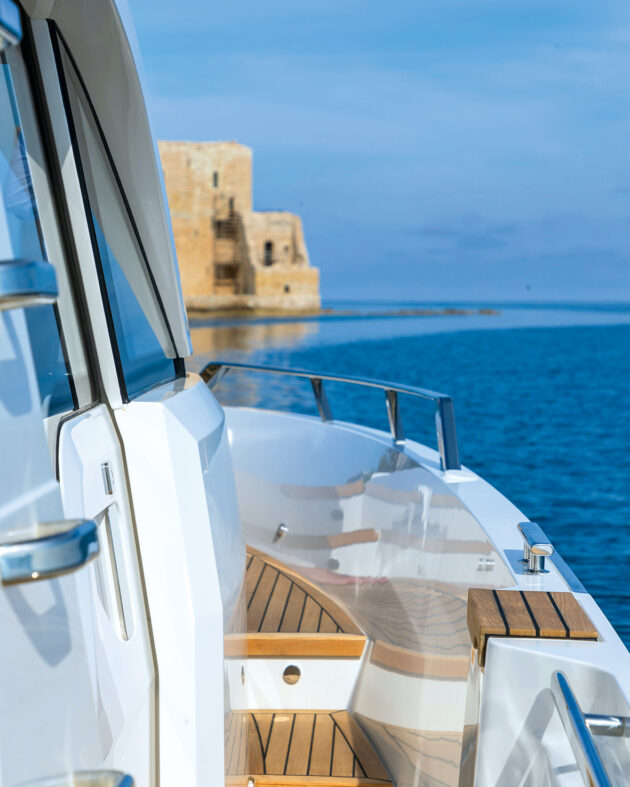
The detailing has some neat superyacht style touches to it. Photos: Jerome Kelagopian & Hugo Andreae
Cabin Space
The deep set cockpit and walkaround decks limit space down below to a single open plan cabin with a separate heads forward but at least it’s a very nicely designed space with plenty of natural light coming in through the eye-level windows (even if they only look out onto the gunwales) and lots of smart detailing.
The standard fitout down here includes a vee-shaped sofa but you can upgrade this with a hi-lo table that converts to a double berth or a less versatile but more comfortable permanent double bed.
Article continues below…

Windy SR28 CC review: world class driving in a smaller package

Windy SR44 review: 10 years in the making and well worth the wait
High quality fabrics, textured bulkhead and deckhead linings, flashes of colour inside the lockers and expensive-looking lights and fittings go some way to justifying its superyacht style pretensions. Quite rightly for a day boat with overnighting facilities, the heads compartment is granted a generous amount of space with full standing headroom, a decent electric toilet and a separate shower compartment with a glass door.
Unlike the W40 Camira, there is no second cabin tucked under the cockpit behind the companionway stairs but if you opt for the outboard powered boat, there is an option to convert the empty engine bay into a surprisingly decent aft cabin.
To give this sufficient headroom, the whole sunpad rises up on electric struts at each corner, unravelling a set of integrated canopies as it lifts like the roof tent of VW Campervan. Watching it all unfold is a great piece of quayside theatre but an expensive one at €28,000.
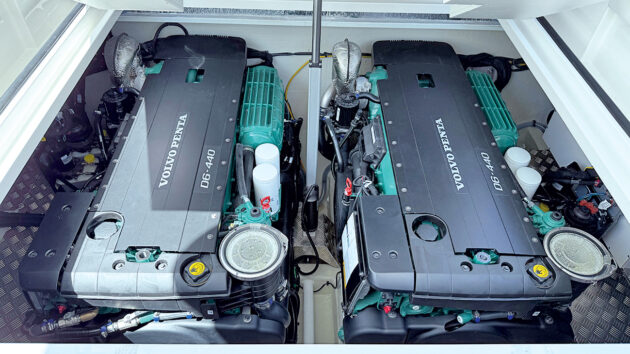
Twin diesels provide plenty of shove but are quite vocal. Photos: Jerome Kelagopian & Hugo Andreae
Performance and Handling
The helm layout is pure Windy; mounted as close to the centreline as possible and equipped with Shox suspension seats, a tilting wheel and a comprehensive dash layout including physical switches for all the essential items and up to two 19in glass cockpit MFDs for the rest, it’s a lesson in good ergonomics.
Even the throttles are mounted on a small extension to bring them closer to the driver. This ensures it just as comfortable to use when sitting or standing, our only minor quibble is that shorter drivers may find the base of the windscreen a too high to give a clear view of the horizon when climbing onto the plane.
Performance from the big twin diesels is solid rather than scintillating – at 10 tonnes the SR40 is almost twice the weight of a 34 Alizé and 2 tonnes more than a Camira of similar length. It still broke the 40-knot barrier and it’s impressively efficient too, burning a relatively modest 3.6 lpm at 30 knots (compared to 4.4 lpm for a Fairline Targa 40) for a range of over 250nm, but by Windy standards it’s merely quick rather than exhilarating.
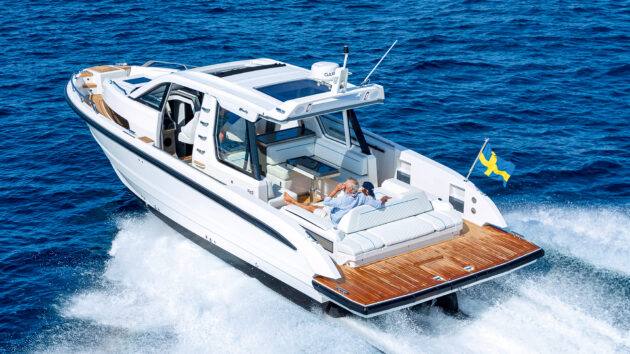
The sliding backrest and angled side bolsters keep occupants secure whether facing forwards or backwards. Photos: Jerome Kelagopian & Hugo Andreae
It’s a similar story when it comes to the handling. The extra weight and higher centre of gravity of that hard top means it lacks the lightning-quick responses of the open boats but by the measure of any other yard this is still a very agile performer.
The optional automatic Humphree Interceptors do a fine job controlling the trim and list, but by limiting the angle of heel during a turn, they take some of the fun out of it so we’d advise either upgrading to the full coordinated turn option or switching them off entirely when you fancy a play behind the wheel.
Perhaps more importantly, the Windy SR40 still coped very well with the lumpy conditions of our test, and the extra warmth and protection provided to the entire cockpit by the hard top makes a massive difference to everyone’s comfort.
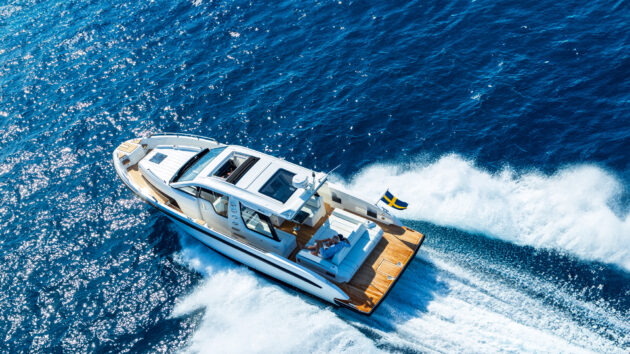
The brief was to create a fast and safe multi-purpose family sportsboat. It certainly lives up to that billing
The only unfortunate side effect of having a semi-enclosed wheelhouse is its tendency to trap and reflect the noise of the big diesel engines, which could become a little tiring on longer journeys,. Windy is aware of this and says it is planning to improve the sound insulation of the engine bay and air intakes.
It would also be interesting to try the outboard variant to see if this is notably quieter as well as quicker – Windy claims the big V12s give a top speed north of 50 knots!
Windy SR40 specifications
LOA: 40ft 0in (13.05m)
BEAM: 13ft 1in (4.00m)
AIR DRAFT: 11ft 4in (3.45m)
DISPLACEMENT: 10-10.4 tonnes
FUEL CAPACITY: 1,130 litres
WATER CAPACITY: 200 litres
ENGINES: 2 x 440hp Volvo Penta D6, 3 x 400hp or 2 x 600hp Mercury outboard
RCD: B
CONTACT: windyboats.com
Windy SR40 costs and options
Price From: €627,800 ex tax (2 x D6)
3 x 400hp Mercury V10: €628,150
2 x 600hp Mercury V12: €639,150
Joystick for sterndrives: €11,000
Aft cabin (outboard only): €28,000
Hydraulic platform (inboard only): €30,500
Seakeeper 4 stabiliser: €68,000
Teak decking: €20,000
 If you enjoyed this….
If you enjoyed this….
Motor Boat & Yachting is the world’s leading magazine for Motoryacht enthusiasts. Every month we have inspirational adventures and practical features to help you realise your sailing dreams, as well as tests and news of all the latest motorboats.
Plus you’ll get our quarterly Custom Yachting supplement where we share the last on offer in the superyacht world and at the luxury end of the market.
Build your knowledge with a subscription delivered to your door. See our latest offers and save at least 30% off the cover price.
Note: We may earn a commission when you buy through links on our site, at no extra cost to you. This doesn’t affect our editorial independence.
Verdict
The SR40 feels like a pivotal boat for Windy. Here at last is a practically minded weekender that offers most of the usual Windy thrills and build quality but with enough protection to be used comfortably all year round in both hot and cold climates. It may not be quite as pretty or engaging to drive as Windy’s open sportsboats but that’s a small price to pay for the extra versatility it offers, especially when fitted with those excellent sliding side doors. If you can live with the lack of a permanent second cabin and the premium pricing, it really does deliver the best of both worlds.
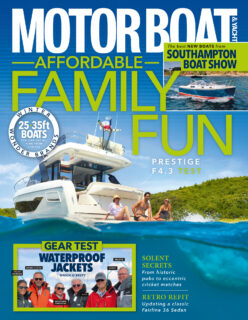

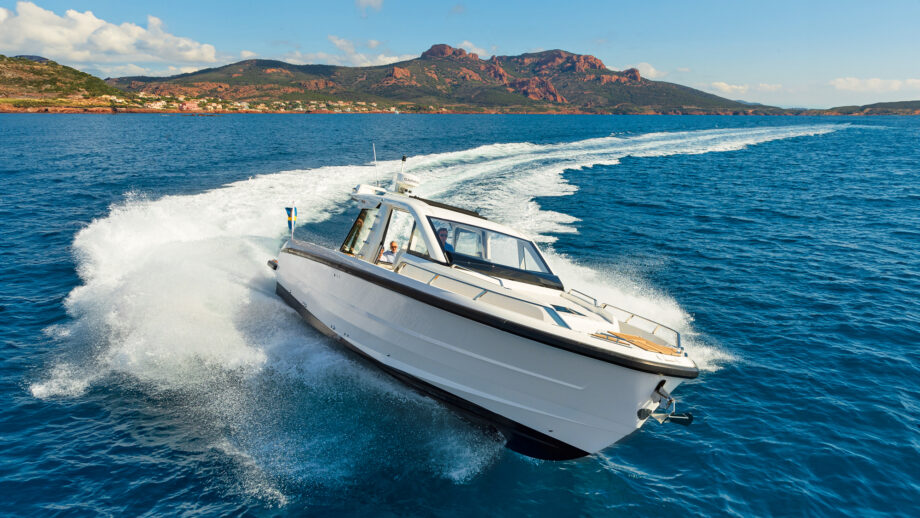
 If you enjoyed this….
If you enjoyed this….